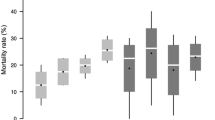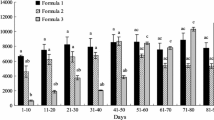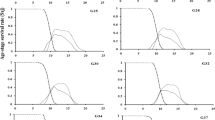Abstract
Adult survival, puparial production, weight and viability, and the sex ratio of adults emerging from puparia of Glossina morsitans morsitans Westwood maintained through four successive reproductive cycles on daily (SO), every other day (SI) and every third day (S2) feeding regimen, respectively were investigated at Chilanga, Zambia. Only in puparial production (0.8 under SO and SI, 0.7 under S2) and puparial weight (25.1±0.2mg under S0, 24.1±0.3mg under S1, 22.5±0.3mg under S2) were significant differences (P<0.05 and <0.01 respectively) detected between feeding regimens. Nevertheless, a combination of SI and S2 regimens is recommended for further evaluation as a more convenient and economical alternative to the SO regimen for tsetse mass production in Africa.
Résumé
On a étudié a Chilanga, en Zambie, la survie adulte, la production de pupes, le poids et la viabilité, ainsi que la proportion d’âge des Glossina morsitans morsitans Westwood adultes émergeant des pupes et entretenues aux trois régimes d’alimentation, journalier (S0), un jour sur deux (S1), un jour sur trois (S2) respectivement, pendant 4 cycles de reproduction successifs. C’est seulement dans la production des pupes (0,8 pour les régimes SO et SI, 0,7 pour S2) et dans le poids des pupes (25,1±0,2mg pour S0, 24,1±0,2mg pour S0, 24,1±0,3mg pour S1, 22,5±0,3mg pour S2) qu’on a remarqué des différences significatives (P<0,5 et<0,01 respectivement) entre les régimes d’alimentation. Néanmoins, une évaluation d’une combinaison des régimes SI et S2, comme alternatif plus commode et plus économique par rapport au régime S0, est recommandée pour la production en masse des mouches tsé-tsé en Afrique.
Similar content being viewed by others
References
Hoffman R. (1954) Zur Fortpflanzugsbiologie und zur intrauterinen Entwicklung von Glossina palpalis. Acta trop. 11, 1–57.
Langley P.A. (1977) Physiology of tsetse flies (Glossina spp.) (Diptera: Glossinidae): A review. Bull. ent. Res. 67, 523–574.
Langley P.A. and Pimley R.W. (1975) Quantitative aspects of reproduction and larval nutrition in Glossina morsitans morsitans Westw. (Diptera, Glossinidae) fed in vitro. Bull. ent. Res. 65, 129–142.
Leegwater-Van Der Linden M.E. (1961) Effect of a four-day-a-week feeding regimen versus daily feeding on the reproduction of Glossina pallidipes. Ent. exp. appl. 29, 169–176.
Madubunyi L.C. (1987) Performance of Glossina morsitans morsitans reared under various feeding regimens in Zambia. Ent. exp. appl. 45 (In Press).
Mellanby H. (1937) Experimental work on reproduction in the tsetse fly, Glossina palpalis. Parasitology 29, 131–144.
Tobe S.S. and Davey K.G. (1971) Some modifications for the laboratory rearing of Glossina austeni Newst. Can. J. Ecol. 49, 577–579.
Author information
Authors and Affiliations
Rights and permissions
About this article
Cite this article
Madubunyi, L.C. Survival and Productivity of the Tsetse, Glossina morsitans morsitans Westwood (Diptera: Glossinidae) Maintained Under Different Feeding Regimens Through Four Successive Reproductive Cycles in Zambia. Int J Trop Insect Sci 10, 75–80 (1989). https://doi.org/10.1017/S1742758400003374
Received:
Published:
Issue Date:
DOI: https://doi.org/10.1017/S1742758400003374




